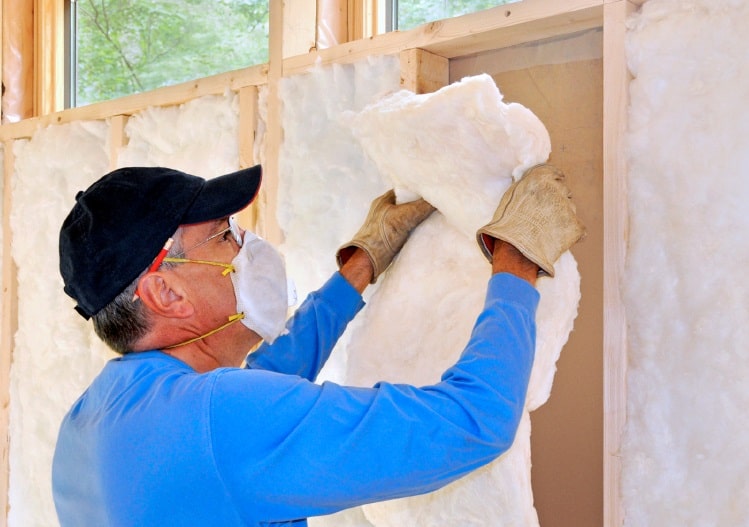If you’re like most homeowners, insulating a garage may not be high on your list of home improvement projects – but it should be. Adding insulation to a garage delivers a great return on investment in terms of energy savings throughout the year, and the benefits don’t stop there.
A well-insulated garage can help extend the life of your vehicles, increase the value of your home, and even provide critical protection against fires.

What Are the Benefits of Insulating a Garage?
Your garage is one of the largest and most frequently-used rooms in your home, and chances are it is also one of the most neglected spaces. The good news is that giving your garage a little love can lead to big benefits. The cost to insulate garage walls and ceilings is also likely much lower than you might expect.
Here are some of the many perks you’ll enjoy by insulating your garage:
Regulates Garage Temperature
- The air temperature in your garage will be much warmer in the winter and cooler in the summer. Insulation eliminates that uncomfortable rush of frigid or humid air that enters your home every time you open the door to the garage.
- You’ll be able to store temperature-sensitive cleaners, paints, and tools without worrying they’ll either freeze or melt.
- If you have water lines running through the walls of your garage, adding insulation will help prevent frozen pipes.
- In hot, humid climates, insulating your garage can help keep moisture levels down to combat rust on your car, metal tools, bicycles, and other metal surfaces.
Improves Your Garage Hobby Space
- If your garage serves double-duty as a workshop, adding insulation will dramatically decrease sound transmission, helping to keep your family (and neighbors) happy while testing out your latest power tools.
- Car lovers can be reassured knowing their prized possessions will be better maintained with effective garage insulation.
Adds Safety Precautions
- Insulating the walls of your garage and adding drywall places a layer of protection around electrical wires and cables in your walls from damage caused by mice and other rodents.
- Garage insulation can help prevent deadly carbon monoxide gases from seeping through your walls into your living spaces.
Insulating a garage can also add a significant level of fire protection for your family since the best insulation for garages is fire-rated. This means the insulation won’t release toxic gases, smoke, or burn quickly if exposed to flames. This protection can make all the difference if an accidental fire starts in your garage.
Can Insulating a Garage Help Extend the Life of a Car?
Absolutely.
Parking your ride in a well-insulated garage protects it against temperature extremes that can cause premature weather-related wear and tear. Vehicles today are filled with sensitive electronics, plastic parts, and foams that can break down faster than anticipated when exposed to prolonged hot or cold environments.
Low temperatures slow the chemical reactions needed to power your car battery to turn over your engine. This can result in your car starter and alternator working even harder to get a car going in a cold garage. And because today’s cars have electronic systems that put a constant drain on the battery, a battery that isn’t fully charged can freeze in garages that reach -1 C.
Parking in a hot garage can also take a take a toll on your car battery. Hot temperatures can quite literally ‘fry’ a battery, leading to irreversible heat deterioration from corrosion. Storing your car in a well-insulated garage is a simple way to extend the life of your vehicle. With the trends moving towards hybrid and electric cars, insulating your garage simply makes sense.

What’s the Best Insulation for Garage Walls?
The best insulation for garage walls depends on where you live, whether or not the walls are already covered with drywall, and if you have a living space located above your garage.
- Fiberglass – The most common type of insulation used in garages. It’s inexpensive, efficient and widely available. It also comes in a variety of pre-cut sizes which helps reduce installation costs.
- Fire-resistant rigid foam – Also an option for insulation because it delivers a relatively high insulation value (R-value) relative to its thickness, and it can be used in shallow spaces.
- Spray foam insulation – A premium product that will definitely increase the cost to insulate garage walls in your home, but may be worth the investment if you use your garage as a workshop, or to store high-value vehicles.
What About Insulating a Garage Door?
If your existing garage door isn’t insulated, you can either add insulation to it or replace it with a ready-made insulated garage door.
Which option you choose comes down to a few factors, such as the age and condition of your current door. It’s also important to consider whether or not you’re up to tackling a DIY project. There’s a number of garage door insulation kits on the market, or you can opt to insulate metal door panels by fitting rigid foam.
Keep in mind that a new, insulated garage door will come complete with a new rubber gasket along the bottom. This gasket will prevent both harsh weather as well as unwelcome critters from getting into your garage.
Don’t Forget to Weatherstrip Your Garage
You wouldn’t leave the weatherstripping off a window or door in your living space, and the same rule applies to your garage. Be sure to complete your garage insulation project by sealing all gaps around the windows and doors. Selecting high-quality weatherstripping will maximize the efficiency of your garage insulation project.
The next time you’re looking for a home improvement project that delivers a great return on your investment, give some serious thought to insulating your garage.
This post first appeared on Redfin.com. To see the original, click here.


Its like you learn my thoughts! You appear to understand so much
about this, such as you wrote the e book in it or something.
I believe that you could do with some p.c. to drive the message home a bit, however
other than that, that is excellent blog. A fantastic read.
I’ll definitely be back.
Do you have any video of that? I’d love to find out more details.